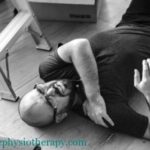What is Anterolateral impingement?
Anterolateral impingement is a Painful condition, limiting the full range of ankle motion due to soft tissue or osseous (bony) pathology. Pain may elicit dorsiflexion and eversion movements of the ankle. It can be due to soft tissue thickening, caused as a result of the healing process wherein a lot of inflamed tissue deposits around the torn tissue. Commonly seen in athletes with prior trauma that extends into the Ankle Joint. The impingement process begins when an inversion sprain tear of the anterior talofibular, and/or the calcaneofibular ligament. Although many authors have suggested the involvement of the lower band of the anterior inferior tibiofibular ligament. The injury is not severe enough to cause chronic instability, however, inadequate immobilization and Rehabilitation can lead to chronic inflammation in the ligament, resulting in the formation of scar tissue. The scar then becomes trapped between the talus and the lateral malleolus, causing irritation, pain, and further synovitis.
It may be bony, tibial bone spur impinging on the talus can become a source of chronic ankle pain and limitation of ankle motion in athletes.
Initial treatment involves physical therapy modalities and Nonsteroidal anti-inflammatory medications. The patients who don’t respond to conservative treatment require arthroscopic debridement.
Anterolateral impingement may appear as a result of inappropriate rehabilitation of an earlier ankle/ high ankle sprain, so, the rehabilitation is basically similar to these conditions.
Treatment Of Anterolateral Impingement
During the acute phase of rehabilitation, the primary aim is to reduce pain and swelling. This can be achieved through, The initial treatment can be abbreviated as PRICE – protection, Rest, Ice, Compression, and Elevation.
The patient may have a painful limp, so the leg needs to be rested from complete weight-bearing activities. The patient may need to be on partial-weight-bearing, a wedged walking boot or heel wedges may be used to temporarily relieve pressure in the anterolateral compartment.
Ice is a simple and effective modality to reduce pain and swelling. Apply for 10-15 minutes every 3 to 4 hours during the initial inflammatory phase.
Anti-inflammatory medication may help reduce pain and swelling. Supportive Kinesio taping can support the injured soft tissue.
The posterior structure needs to be stretched to relieve pressure on the anterior side of the ankle through proper muscle balance of anterior and posterior structures. Precaution should be taken while stretching as it may aggravate the pain. The fascia and muscles of foot also need to be stretched.
The other aims of rehabilitation will target –
- Improvement of muscle strength and length around the ankle and foot.
- Improvement of joint range of motion of ankle and foot
- Biomechanical movement of ankle and foot correction
- Improvement of balance and proprioception
- Speed, agility, power, and endurance training
- Return to sports/ functional day to day activity





